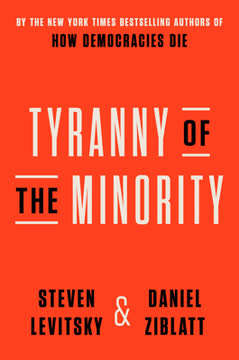Key Takeaways
1. The Trump presidency challenged press freedom and journalistic integrity
"I love the First Amendment; nobody loves it better than me. Nobody. I mean, who uses it more than I do?"
Unprecedented attacks on media. Donald Trump's presidency marked a dramatic shift in the relationship between the White House and the press. He routinely denounced unfavorable coverage as "fake news," called journalists "enemies of the people," and threatened to change libel laws to make it easier to sue media outlets. This rhetoric had a chilling effect, emboldening autocrats worldwide to crack down on journalists.
Maintaining journalistic standards. Despite the hostile climate, The New York Times and other major outlets worked to uphold journalistic integrity. They focused on fact-based reporting, gave the administration opportunities to comment, and resisted the urge to adopt an oppositional stance. However, they also had to adapt to an unprecedented volume of news and controversies emanating from the White House.
Key challenges:
- Responding to "fake news" accusations
- Covering an unconventional and combative president
- Maintaining objectivity while holding power accountable
- Educating the public on the importance of press freedom
2. Libel lawsuits and "fake news" accusations became weapons against the media
"The failing @NYTimes has been wrong about me from the very beginning. Said I would lose the primaries, then the general election. FAKE NEWS!"
Rise in litigation. The Trump era saw an increase in libel lawsuits against media organizations, often by wealthy individuals or corporations seeking to intimidate journalists. Notable cases included Sarah Palin's suit against The New York Times and coal baron Bob Murray's actions against various outlets. These suits, even when unsuccessful, consumed significant resources and time.
Weaponizing "fake news." Trump's frequent use of the term "fake news" to discredit unfavorable coverage had far-reaching consequences. It eroded public trust in journalism and was adopted by authoritarian leaders worldwide to justify crackdowns on press freedom. This created a challenging environment for journalists trying to report accurately on complex issues.
Defenses against libel:
- First Amendment protections
- Actual malice standard for public figures
- Emphasis on thorough fact-checking and editorial processes
3. National security reporting carries high stakes and ethical dilemmas
"There had been rumors of sexual improprieties involving the maharishi and female followers."
Balancing transparency and security. National security reporting often involves wrestling with competing interests: the public's right to know versus potential risks to national security. The Times faced difficult decisions in publishing stories based on classified information, such as details about cyberattacks on North Korea's missile program or CIA operations in Syria.
Government pushback. Administrations consistently pressured media outlets to withhold or delay publication of sensitive stories. While sometimes these requests were justified, often they were attempts to avoid embarrassment or accountability. Journalists and editors had to carefully weigh each situation, consulting with legal counsel and sometimes giving government officials opportunities to comment before publication.
Key considerations in national security reporting:
- Potential harm to ongoing operations or individuals
- Public interest in government actions and policies
- Legal risks of publishing classified information
- Ethical responsibility to inform the public
4. FOIA battles reveal ongoing government secrecy and obstruction
"Secrecy, being an instrument of conspiracy, ought never to be the system of regular government."
Systemic delays and denials. The Freedom of Information Act (FOIA) is meant to ensure government transparency, but in practice, agencies often employ various tactics to avoid or delay releasing information. The New York Times frequently had to resort to lawsuits to obtain documents, facing years-long delays and heavily redacted releases.
Overclassification epidemic. Government agencies routinely overclassify information, making it difficult for journalists and the public to access important data about government operations. This culture of secrecy extends across administrations and poses a significant challenge to accountability and informed public discourse.
Common FOIA obstacles:
- Excessive processing times
- Broad use of exemptions
- "Glomar" responses (neither confirming nor denying existence of records)
- Necessity of litigation to compel compliance
5. International journalism faces increasing danger and hostility
"For most of my time at the paper, to be a lawyer for The Times was to occupy a fairly tidy corner of the First Amendment world."
Rising threats to journalists. Covering international stories, particularly in conflict zones or authoritarian countries, has become increasingly perilous. Journalists face risks of kidnapping, imprisonment, and even murder. The Times had to develop extensive security protocols and crisis management plans to protect its reporters.
Erosion of press freedom globally. Many countries have adopted more restrictive policies toward foreign journalists, limiting access and using legal threats or expulsions to control coverage. The spread of "fake news" rhetoric has provided cover for crackdowns on independent media worldwide.
Challenges in international reporting:
- Physical safety of journalists
- Legal threats and intimidation
- Difficulty accessing sources and information
- Navigating complex geopolitical situations
6. The Times' legal department navigates complex crises and kidnappings
"I knew right then it was over for Harvey Weinstein."
Crisis management. The Times' legal team played a crucial role in handling high-stakes situations, from reporter kidnappings to government threats. These crises required quick thinking, diplomatic skills, and a deep understanding of international law and geopolitics.
Ethical dilemmas. Lawyers often had to balance journalistic principles with practical concerns for safety and legal compliance. This included decisions about whether to publish sensitive information, how to respond to government pressures, and when to involve outside agencies or consultants.
Key responsibilities in crisis situations:
- Coordinating with government agencies and diplomats
- Managing communications with families and stakeholders
- Navigating legal and ethical boundaries
- Protecting sources and confidential information
7. Social media and technology transform the media landscape
"The Amazon Washington Post fabricated the facts on my ending massive, dangerous, and wasteful payments to Syrian rebels fighting Assad.…"
New platforms, new challenges. The rise of social media has dramatically altered how news is consumed and shared. While providing new avenues for reporting and audience engagement, platforms like Twitter also created challenges, such as the rapid spread of misinformation and the blurring of lines between reporting and commentary.
Adapting to digital realities. Traditional media outlets had to evolve their practices to remain relevant in the digital age. This included developing social media strategies, adapting to 24/7 news cycles, and finding ways to monetize online content while maintaining journalistic standards.
Impact of social media on journalism:
- Instant dissemination of news and information
- Direct communication between newsmakers and public
- Challenges in verifying information
- New legal and ethical considerations
8. Sexual misconduct reporting sparks the #MeToo movement
"I wanted to do something inspirational for my children."
Breaking the Weinstein story. The Times' reporting on Harvey Weinstein's history of sexual misconduct helped catalyze the #MeToo movement, leading to a wave of similar revelations across industries. This reporting required careful legal navigation, including dealing with non-disclosure agreements and potential defamation claims.
Broader impact. The #MeToo reporting led to significant cultural shifts, prompting discussions about workplace power dynamics, the prevalence of sexual harassment, and the systems that enabled such behavior to persist. It also raised complex legal and ethical questions about privacy, due process, and the role of journalism in social change.
Challenges in #MeToo reporting:
- Verifying sensitive and often years-old claims
- Protecting sources who fear retaliation
- Navigating legal threats from powerful individuals
- Balancing public interest with privacy concerns
9. Press freedom requires constant vigilance and public support
"Democracy Dies in Darkness"
Ongoing threats. Press freedom faces continuous challenges, from government attempts to control information to economic pressures on news organizations. The rise of authoritarianism globally and erosion of democratic norms in established democracies pose significant threats to independent journalism.
Public engagement crucial. Maintaining a free press requires not just legal protections but also public understanding and support. Media organizations must work to educate the public about the importance of journalism in a democracy and build trust through transparent, ethical reporting.
Keys to preserving press freedom:
- Strong legal protections for journalists and sources
- Public education about the role of the press in democracy
- Diverse, financially sustainable news ecosystems
- International cooperation to support press freedom globally
Last updated:
Review Summary
Truth in Our Times is praised for its insightful look into press freedom and the First Amendment. Readers appreciate McCraw's behind-the-scenes perspective on journalism and legal challenges faced by the New York Times. The book's focus on Trump's attacks on media and the changing landscape of truth in journalism resonates with many. While some find it biased against Trump, most commend McCraw's defense of press freedom and his engaging writing style. Critics note the book's narrow focus on recent events and lack of broader historical context.
Similar Books





Download PDF
Download EPUB
.epub digital book format is ideal for reading ebooks on phones, tablets, and e-readers.




